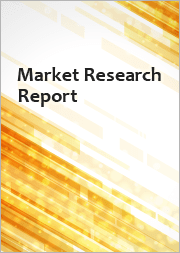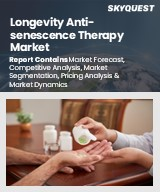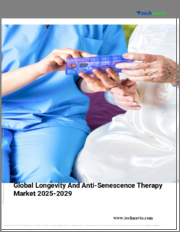
|
시장보고서
상품코드
1732137
안티에이징 의약품 시장 : 유형별, 치료별, 지역별(2026-2032년)Anti-Aging Drugs Market By Type (Anti-Wrinkle Products, Anti-Stretch Mark Products, Hair Color Products), Treatment (Hair Restoration, Anti-Pigmentation, Adult Acne Therapy), & Region for 2026-2032 |
||||||
노화 방지 의약품 시장 평가, 2026-2032년
세계 고령화율 증가와 건강한 노화에 대한 인식이 높아지면서 노화 방지 의약품에 대한 수요가 증가하고 있습니다. 평균 수명이 늘어남에 따라 더 많은 사람들이 젊음을 유지하고 주름, 피부 탄력 저하, 인지 기능 저하, 관절 장애와 같은 노화와 관련된 장애를 피할 수 있는 방법을 모색하고 있습니다. 이에 따라 미용상 우려와 노화에 따른 신체내 건강 문제를 모두 해결하는 노화 방지 의약품에 대한 관심이 높아지면서 시장은 2024년에 910억 5,000만 달러의 매출을 돌파하며, 2032년에는 약 1,602억 4,000만 달러의 평가액에 달할 전망입니다.
의료 연구, 특히 재생의료와 바이오테크놀러지의 발전은 노화방지 의약품 산업의 확장에 필수적입니다. 줄기세포 치료, 유전자 편집, 노화 세포를 표적으로 하는 세노리틱스(노화 세포를 표적으로 하는 약물)의 발전은 세포 수준에서 노화 과정을 되돌리거나 감소시키는 흥미로운 해답을 제공하여 2026-2032년 연평균 복합 성장률(CAGR) 7.32% 시장 성장을 가능하게 하고 있습니다.
항노화 의약품 시장 정의/개요
항노화 의약품은 세포 또는 분자 수준에서 노화의 영향을 지연시키거나 역행시키는 의약품입니다. 세포, 조직, 장기의 시간 경과에 따른 퇴화 등 노화를 유발하는 생물학적 메커니즘을 표적으로 삼습니다. 이러한 약물은 산화 스트레스, 염증, 유전적 손상 등 노화의 가속화와 관련된 다양한 상태를 표적으로 삼는 방식으로 작용합니다.
주로 노화와 관련된 질병을 치료하고 노화에 따른 일반적인 삶의 질을 개선하는 데 사용됩니다. 중요한 용도 중 하나는 피부 노화, 특히 주름, 잔주름, 피부 유연성 상실과 같은 피부 노화 치료입니다. 이러한 약물은 콜라겐 형성을 촉진하고, 보습을 강화하고, 환경적 피해로부터 피부를 보호함으로써 피부 노화 과정을 줄이거 나 역전시키는 것을 목표로합니다.
세포 노화 및 재생의료에 대한 과학적 연구가 진행됨에 따라 노화방지 의약품의 미래는 매우 유망합니다. 가장 유망한 분야 중 하나는 노화, 텔로미어 단축, 산화 스트레스 등 분자 및 세포 수준에서 노화의 근본 원인을 다루는 의약품 개발입니다.
피부과 의사 증가가 노화 방지 의약품 시장을 촉진하는가?
피부과 의사 수 증가는 전문적인 피부 관리 치료 및 처방약에 대한 접근성을 높이기 때문에 노화 방지 의약품 시장의 주요 촉진요인으로 작용하고 있습니다. 이러한 피부과 인력의 확대는 노화방지 의약품의 진단, 치료, 처방 증가와 직접적으로 연관되어 있습니다. 미국피부과학회(AAD)에 따르면 미국의 피부과 의사 수는 점차 증가하고 있으며, 2021년 현재 미국에는 약 14,000명의 피부과 전문의가 있으며, 이는 2015년 약 11,000명에서 6년간 27% 증가한 수치입니다.
국립의료통계센터에 따르면 2018년 피부과 의사들은 2,070만 건 이상의 처방전을 작성했으며, 그 중 대부분은 노화 방지 치료였다고 합니다. 메디케어 메디케이드 서비스 센터의 데이터에 따르면 피부과 치료제에 대한 지출은 5년간 49% 증가하여 2015년 75억 달러에서 2020년에는 112억 달러에 달합니다. 이러한 처방과 비용 증가는 노화 방지 의약품에 대한 수요 증가를 반영하고 있으며, 피부과 의사의 수가 증가함에 따라 이를 지원하고 있습니다.
노화 방지 의약품의 높은 비용이 노화 방지 의약품 시장의 걸림돌로 작용하는가?
노화방지 치료제의 높은 비용은 시장 확대를 저해할 수 있습니다. 이러한 치료법, 특히 최신 기술, 줄기세포 연구, 유전자 치료를 포함한 많은 치료법은 대규모 연구개발 및 제조 공정을 필요로 하므로 비용이 높습니다. 그 결과, 이러한 치료법은 특히 경제적인 여유가 중요한 저개발 국가에서는 인구의 상당 부분이 이용할 수 없을 수 있습니다. 이러한 가격 접근성의 제한은 잠재적 고객층을 감소시키고 시장 성장을 저해할 수 있습니다.
이러한 의약품은 고가이기 때문에 보험 적용 및 상환 정책에도 문제가 있습니다. 많은 의료 보험사들은 노화 방지 치료가 의학적으로 필요한 것이 아니라 선택적 또는 미용적인 것으로 간주하여 보험금 지급을 거부하는 경우가 있습니다. 이러한 보험이 적용되지 않기 때문에 치료비 전액을 개인이 부담하게 되어 치료에 대한 접근성이 더욱 제한됩니다. 결과적으로 고가의 노화 방지 의약품의 일반 시장은 비용 절감, 보험 적용 확대 또는 저렴한 대체요법의 발전이 없는 한 폐쇄적인 시장으로 남을 가능성이 높습니다.
목차
제1장 세계의 안티에이징 의약품 시장의 서론
- 시장 개요
- 조사 범위
- 전제조건
제2장 개요
제3장 VERIFIED MARKET RESEARCH의 조사 방법
- 데이터 마이닝
- 밸리데이션
- 1차 자료
- 데이터 소스 리스트
제4장 세계의 안티에이징 의약품 시장 전망
- 개요
- 시장 역학
- 촉진요인
- 억제요인
- 기회
- Porter's Five Forces 모델
- 밸류체인 분석
제5장 세계의 안티에이징 의약품 시장 : 유형별
- 개요
- 안티 링클 제품
- 안티 스트레치 마크 제품
- 헤어 컬러 제품
- 기타 제품
제6장 세계의 안티에이징 의약품 시장 : 치료별
- 개요
- 모발 재생
- 색소침착 방지
- 성인 여드름 치료
- 유방확대술
- 지방흡입
- 케미컬 필링
제7장 안티에이징 약 세계 시장 : 지역별
- 개요
- 북미
- 미국
- 캐나다
- 멕시코
- 유럽
- 독일
- 영국
- 프랑스
- 기타 유럽
- 아시아태평양
- 중국
- 일본
- 인도
- 기타 아시아태평양
- 세계의 기타 지역
- 라틴아메리카
- 중동 및 아프리카
제8장 세계의 안티에이징 의약품 시장의 경쟁 구도
- 개요
- 각사의 시장 순위
- 주요 개발 전략
제9장 기업 개요
- PrivateLabelSk
- Allergan
- Johnson and Johnson
- Alma Lasers
- Photomedex
- Estee Lauder
- Lumenis
- Solta Medical
- Beiersdorf
- Cynosure
제10장 부록
- 관련 조사
Anti-Aging Drugs Market Valuation - 2026-2032
The rising global aging population and greater awareness about healthy aging are driving up demand for anti-aging medications. As life expectancy rises, more people are looking for ways to stay young and avoid age-related disorders like wrinkles, diminished skin elasticity, cognitive loss, and joint difficulties. This has driven increased interest in anti-aging medications that address both cosmetic concerns and internal health issues connected with aging by enabling the market to surpass a revenue of USD 91.05 Billion valued in 2024 and reach a valuation of around USD 160.24 Billion by 2032.
Advances in medical research, particularly in regenerative medicine and biotechnology are critical to extending the anti-aging pharmaceuticals industry. Advances in stem cell therapies, gene editing, and senolytics (drugs that target aging cells) are providing intriguing answers for reversing or reducing the aging process at the cellular level by enabling the market to grow at a CAGR of 7.32% from 2026 to 2032.
Anti-Aging Drugs Market: Definition/ Overview
Anti-aging medications are medicinal chemicals that slow or reverse the effects of aging on the cellular or molecular level. They want to target the biological mechanisms that cause aging such as the degeneration of cells, tissues, and organs over time. These medications work by targeting a variety of conditions that have been linked to accelerated aging including oxidative stress, inflammation, and genetic damage.
They are used primarily to treat age-related illnesses and improve the general quality of life as people age. One important application is the treatment of skin aging, specifically wrinkles, fine lines, and loss of skin suppleness. These medications are intended to reduce or reverse the skin's aging process by increasing collagen formation, enhancing hydration, and guarding against environmental harm.
The future of anti-aging medications seems promising as a scientific study into cellular aging and regenerative medicine advances. One of the most promising areas is the development of medications that address the underlying causes of aging at the molecular and cellular levels such as senescence, telomere shortening, and oxidative stress.
Will Increasing Number of Dermatologists Drive the Anti-Aging Drugs Market?
The growing number of dermatologists is a major driver of the anti-aging drugs market as it increases access to specialist skincare treatments and prescription pharmaceuticals. This expansion in the dermatology workforce is directly related to increased diagnosis, treatment, and prescription of anti-aging medications. According to the American Academy of Dermatology (AAD), the number of dermatologists in the United States is gradually rising. As of 2021, there were approximately 14,000 board-certified dermatologists in the United States, up from around 11,000 in 2015, marking a 27% growth in six years.
According to the National Center for Health Statistics, dermatologists wrote over 20.7 million prescriptions in 2018, the majority of which were for anti-aging treatments. According to data from the Centers for Medicare and Medicaid Services, spending on dermatological medications climbed by 49% over five years, from USD 7.5 Billion in 2015 to USD 11.2 Billion in 2020. This increase in prescriptions and cost reflects a growing demand for anti-aging medications, which is aided by an expanding number of dermatologists.
Will High Costs of Anti-Aging Drugs Hamper the Anti-Aging Drugs Market?
The high cost of anti-aging medications may impede the market's expansion. Many of these treatments, particularly those involving modern technologies, stem cell research, and gene therapies, need extensive research, development, and manufacturing processes which raises their cost. As a result, these treatments may be inaccessible to a substantial portion of the population, particularly in underdeveloped countries where affordability is crucial. This limited affordability may reduce the potential client base delaying the market's growth.
These medications' high costs provide issues for insurance coverage and reimbursement policies. Many health insurance providers may refuse to pay for anti-aging therapies because they are considered elective or cosmetic rather than medically required. This absence of coverage further restricts access to these treatments as individuals shoulder the entire cost of treatment. As a result, the general market for high-priced anti-aging pharmaceuticals may remain confined unless there are considerable advances in cost reduction, expanded insurance coverage, or alternative cheap therapies.
Category-Wise Acumens
Will Increasing Awareness of the Harmful Effects of Environmental Factors Drive Growth in the Type Segment?
Anti-wrinkle creams are dominant among a wide range of demographics. Wrinkles are one of the most apparent and well-known markers of aging, thus anti-wrinkle treatments are a popular choice for people who want to seem younger. The growing emphasis on skincare regimens, increased knowledge of the damaging effects of environmental factors such as UV rays and pollution on the skin, and the expanding popularity of non-invasive treatments all contribute to the broad demand for anti-wrinkle solutions.
Another reason for anti-wrinkle products' popularity is their widespread availability and variety which cater to a wide range of consumer preferences and budgets. Furthermore, celebrity endorsements, beauty influencers, and the increased popularity of beauty-focused social media content have boosted demand for these products appealing to both younger customers as a preventative measure and older consumers looking to diminish obvious indications of aging.
Will the Growing Hormonal Imbalances and Stress Drive the Treatment Segment?
Hair restoration is a dominant market because of the increasing occurrence of hair loss in both men and women. Aging, hormone imbalances, and stress are all significant causes of hair thinning and baldness, hence hair restoration treatments are in high demand. Hair restoration procedures including hair transplants and regenerative therapies have grown more accessible, safe, and effective as medical technology has advanced. The rise in less invasive treatments as well as the growing demand for non-surgical options such as PRP (platelet-rich plasma) therapy are driving growth in the market.
The cultural and societal emphasis on aesthetics and young appearance drives the desire for hair restoration. Hair is frequently connected with vitality and youth making it an important part of one's appearance. Unlike other anti-aging therapies which may focus on specific symptoms like pigmentation or wrinkles, hair restoration addresses a broader concern. As a result, it has gained popularity not only among the elderly but also among young people seeking preventive treatment. The excellent success rate of contemporary treatments combined with increased exposure via social media and celebrity endorsements assures that hair restoration remains the dominant anti-aging treatment market.
Country/Region-wise Acumens
Will the Increasing Number of Non-Invasive Cosmetic Treatments Drive the Market in the North American Region?
The North American region dominates the anti-aging drugs market owing to the growing popularity of non-invasive cosmetic procedures. The increased desire for non-invasive cosmetic procedures is reflected in significant industry growth. According to the American Society of Plastic Surgeons (ASPS), 15.7 million minimally invasive cosmetic treatments were conducted in the United States in 2020, despite the COVID-19 epidemic. Botulinum Toxin Type A (Botox) injections, a popular anti-aging treatment, accounted for 4.4 million of these treatments representing a 459% rise from 2000.
According to the National Institutes of Health (NIH), funding for aging research has increased by 31%, from $2.9 billion in 2015 to USD 3.8 Billion in 2021, perhaps leading to more advanced anti-aging drug development. Furthermore, the US International Trade Commission says that the value of imported beauty and skincare preparations including anti-aging treatments, climbed from USD 2.7 Billion in 2015 to USD 3.5 Billion in 2020, reflecting a 30% increase in five years.
Will the Growing Personal Care Sector Drive the Market in the Asia Pacific Region?
Personal care is the fastest-growing driver of the Asia Pacific anti-aging drugs market. This increased development is mostly driven by rising disposable incomes, changing lifestyles, and an aging population that is increasingly concerned with keeping a young appearance.
Asia Pacific's personal care business is expanding rapidly which has a direct impact on the anti-aging medicine market. According to the United Nations Economic and Social Commission for Asia and the Pacific (ESCAP), the region's middle class is predicted to climb from 2 billion in 2020 to 3.5 billion by 2030, a 75% increase.
Another major driver of the anti-aging pharmaceuticals market is Asia Pacific's aging population. According to the United Nations Department of Economic and Social Affairs, the number of individuals aged 65 and up in Asia will rise from 395 million in 2020 to 587 million by 2030, representing a 48.6% increase in just ten years. According to the Ministry of Internal Affairs and Communications, 28.7% of Japan's population was 65 or older in 2020, the highest proportion in the world. South Korea's National Statistics Office projects that the country will become a "super-aged society" by 2025, with 20% of the population aged 65 and up. These demographic trends are fueling a significant demand for anti-aging medications and treatments.
Competitive Landscape
The Anti-Aging Drugs Market is a dynamic and competitive space characterized by diverse players vying for market share. These players are on the run for solidifying their presence through the adoption of strategic plans such as collaborations, mergers, acquisitions, and political support. The organizations focus on innovating their product line to serve the vast population in diverse regions.
Some of the prominent players operating in the anti-aging drugs market include:
PrivateLabelSk
Allergan
Johnson and Johnson
Alma Lasers
Photomedex
Estee Lauder
Lumenis
Solta Medical
Beiersdorf
Cynosure
Procter & Gamble
L'Oreal
Latest Developments
In February 2024, Rejuvenate Bio found that gene therapy-mediated partial reprogramming can lengthen longevity in normal, old mice.
In July 2023, researchers from Harvard Medical School discovered the first chemically induced cellular aging reversal using six novel chemical compounds that can restore the young condition of cells within a week.
In January 2023, the University of Bristol and the MultiMedica Group in Italy discovered a breakthrough anti-aging gene that can rejuvenate heart cells by ten years.
Anti-Aging Drugs Market, By Category
- Type:
- Anti-wrinkle Products
- Anti-stretch Mark Products
- Hair Color Products
- Other Products
- Treatment:
- Hair Restoration
- Anti-Pigmentation
- Adult Acne Therapy
- Breast Augmentation
- Liposuction
- Chemical Peel
- Region:
- North America
- Europe
- Asia-Pacific
- South America
- Middle East & Africa
TABLE OF CONTENTS
1 INTRODUCTION OF GLOBAL ANTI-AGING DRUGS MARKET
- 1.1 Overview of the Market
- 1.2 Scope of Report
- 1.3 Assumptions
2 EXECUTIVE SUMMARY
3 RESEARCH METHODOLOGY OF VERIFIED MARKET RESEARCH
- 3.1 Data Mining
- 3.2 Validation
- 3.3 Primary Interviews
- 3.4 List of Data Sources
4 GLOBAL ANTI-AGING DRUGS MARKET OUTLOOK
- 4.1 Overview
- 4.2 Market Dynamics
- 4.2.1 Drivers
- 4.2.2 Restraints
- 4.2.3 Opportunities
- 4.3 Porters Five Force Model
- 4.4 Value Chain Analysis
5 GLOBAL ANTI-AGING DRUGS MARKET, BY TYPE
- 5.1 Overview
- 5.2 Anti-wrinkle Products
- 5.3 Anti-stretch Mark Products
- 5.4 Hair Color Products
- 5.5 Other Products
6 GLOBAL ANTI-AGING DRUGS MARKET, BY TREATMENT
- 6.1 Overview
- 6.2 Hair Restoration
- 6.3 Anti-Pigmentation
- 6.4 Adult Acne Therapy
- 6.5 Breast Augmentation
- 6.6 Liposuction
- 6.7 Chemical Peel
7 GLOBAL ANTI-AGING DRUGS MARKET, BY GEOGRAPHY
- 7.1 Overview
- 7.2 North America
- 7.2.1 U.S.
- 7.2.2 Canada
- 7.2.3 Mexico
- 7.3 Europe
- 7.3.1 Germany
- 7.3.2 U.K.
- 7.3.3 France
- 7.3.4 Rest of Europe
- 7.4 Asia Pacific
- 7.4.1 China
- 7.4.2 Japan
- 7.4.3 India
- 7.4.4 Rest of Asia Pacific
- 7.5 Rest of the World
- 7.5.1 Latin America
- 7.5.2 Middle East & Africa
8 GLOBAL ANTI-AGING DRUGS MARKET COMPETITIVE LANDSCAPE
- 8.1 Overview
- 8.2 Company Market Ranking
- 8.3 Key Development Strategies
9 COMPANY PROFILES
- 9.1 PrivateLabelSk
- 9.1.1 Overview
- 9.1.2 Financial Performance
- 9.1.3 Product Outlook
- 9.1.4 Key Developments
- 9.2 Allergan
- 9.2.1 Overview
- 9.2.2 Financial Performance
- 9.2.3 Product Outlook
- 9.2.4 Key Developments
- 9.3 Johnson and Johnson
- 9.3.1 Overview
- 9.3.2 Financial Performance
- 9.3.3 Product Outlook
- 9.3.4 Key Developments
- 9.4 Alma Lasers
- 9.4.1 Overview
- 9.4.2 Financial Performance
- 9.4.3 Product Outlook
- 9.4.4 Key Developments
- 9.5 Photomedex
- 9.5.1 Overview
- 9.5.2 Financial Performance
- 9.5.3 Product Outlook
- 9.5.4 Key Developments
- 9.6 Estee Lauder
- 9.6.1 Overview
- 9.6.2 Financial Performance
- 9.6.3 Product Outlook
- 9.6.4 Key Developments
- 9.7 Lumenis
- 9.7.1 Overview
- 9.7.2 Financial Performance
- 9.7.3 Product Outlook
- 9.7.4 Key Developments
- 9.8 Solta Medical
- 9.8.1 Overview
- 9.8.2 Financial Performance
- 9.8.3 Product Outlook
- 9.8.4 Key Developments
- 9.9 Beiersdorf
- 9.9.1 Overview
- 9.9.2 Financial Performance
- 9.9.3 Product Outlook
- 9.9.4 Key Developments
- 9.10 Cynosure
- 9.10.1 Overview
- 9.10.2 Financial Performance
- 9.10.3 Product Outlook
- 9.10.4 Key Developments
10 Appendix
- 10.1 Related Research

















